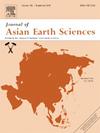俄罗斯东部晚石炭世花岗岩地球化学和年代学:对黑河-嫩江缝合带演化的启示
IF 2.7
3区 地球科学
Q2 GEOSCIENCES, MULTIDISCIPLINARY
引用次数: 0
摘要
黑河-嫩江缝合带是中亚造山带东部的主要缝合带之一,位于兴安和松嫩-张广才山脉之间,从蒙古南部经中国东北部延伸至俄罗斯东部。这些地块的合并史一直存在争议,尤其是晚古生代的合并史。本文报道了黑河-嫩江缝合带东北部两个花岗岩岩体的全岩地球化学和锆石U-Pb年代学数据,目的是对侵位时间和构造背景进行限定。此外,结合我们先前发表的该缝合带俄罗斯部分的数据,我们比较了两个地区之间的构造过程。我们鉴定出两颗二长花岗岩,年龄分别为313±3和307±3 Ma,以及一颗角闪黑云母花岗岩,年龄为306±2 Ma。ca. 313 Ma和ca. 307 Ma二长花岗岩含安妮石,与a2型花岗岩具有地球化学亲和关系。306 Ma角闪-黑云母花岗岩的地球化学特征以及铁长岩、寄生岩和菱铁矿的存在表明其为i型花岗岩。黑河-年江缝合带俄罗斯段的晚石炭世A2型和i型花岗岩形成于313-295 Ma岩浆活动期间,包括306±4 Ma二长花岗岩、301±4 Ma流纹岩和295±4 Ma斜长花岗岩,具有埃达质特征。这些岩石均与兴安、松嫩—张广才地块合并后的碰撞后伸展环境有关。本文章由计算机程序翻译,如有差异,请以英文原文为准。

Geochemistry and geochronology of late Carboniferous granites from eastern Russia: Implications for the evolution of the Heihe–Nenjiang suture zone
The Heihe–Nenjiang suture zone, which is one of the major sutures in the eastern Central Asian Orogenic Belt, occurs between the Xing’an and Songnen–Zhangguangcai Range massifs and extends from southern Mongolia via northeastern China into eastern Russia. The amalgamation history of these massifs is controversial, especially for that during the late Paleozoic. Here we report whole-rock geochemical and zircon U–Pb geochronological data for two granite intrusions in the northeastern Heihe–Nenjiang suture zone with the aim of constraining the emplacement timing and their tectonic setting. In addition, combined with our previously published data for the Russian part of this suture zone, we compare tectonic processes between the two regions. We identified two monzogranites dated at 313 ± 3 and 307 ± 3 Ma, and a hornblende–biotite granite dated at 306 ± 2 Ma. The ca. 313 Ma and ca. 307 Ma monzogranites contain annite and have geochemical affinity to A2-type granites. The geochemistry of the ca. 306 Ma hornblende–biotite granite, and the presence of edenite, pargasite, and siderophyllite, indicate it is an I-type granite. These late Carboniferous A2- and I-type granites in the Russian part of the Heihe–Nenjiang suture zone formed during a 313–295 Ma magmatic event, which include 306 ± 4 Ma monzogranites, 301 ± 4 Ma rhyolites, and 295 ± 4 Ma plagiogranites with an adakitic signature. These rocks are all related to the post-collisional extension setting after the amalgamation of the Xing’an and Songnen–Zhangguangcai Range massifs.
求助全文
通过发布文献求助,成功后即可免费获取论文全文。
去求助
来源期刊

Journal of Asian Earth Sciences
地学-地球科学综合
CiteScore
5.90
自引率
10.00%
发文量
324
审稿时长
71 days
期刊介绍:
Journal of Asian Earth Sciences has an open access mirror journal Journal of Asian Earth Sciences: X, sharing the same aims and scope, editorial team, submission system and rigorous peer review.
The Journal of Asian Earth Sciences is an international interdisciplinary journal devoted to all aspects of research related to the solid Earth Sciences of Asia. The Journal publishes high quality, peer-reviewed scientific papers on the regional geology, tectonics, geochemistry and geophysics of Asia. It will be devoted primarily to research papers but short communications relating to new developments of broad interest, reviews and book reviews will also be included. Papers must have international appeal and should present work of more than local significance.
The scope includes deep processes of the Asian continent and its adjacent oceans; seismology and earthquakes; orogeny, magmatism, metamorphism and volcanism; growth, deformation and destruction of the Asian crust; crust-mantle interaction; evolution of life (early life, biostratigraphy, biogeography and mass-extinction); fluids, fluxes and reservoirs of mineral and energy resources; surface processes (weathering, erosion, transport and deposition of sediments) and resulting geomorphology; and the response of the Earth to global climate change as viewed within the Asian continent and surrounding oceans.
 求助内容:
求助内容: 应助结果提醒方式:
应助结果提醒方式:


